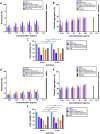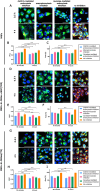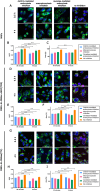Enhanced Delivery and Potency of Chemotherapeutics in Melanoma Treatment via Magnetite Nanobioconjugates
- PMID: 39554413
- PMCID: PMC11561594
- DOI: 10.1021/acsomega.4c07415
Enhanced Delivery and Potency of Chemotherapeutics in Melanoma Treatment via Magnetite Nanobioconjugates
Abstract
Melanoma, known for its aggressive metastatic potential, poses significant treatment challenges. Despite the potent antiproliferative effects of anticancer drugs, systemic toxicity and low water solubility limit their efficacy. This study addresses these challenges by employing magnetite (Fe3O4) nanobioconjugates as a drug delivery system, aimed at enhancing drug solubility and reducing off-target effects in melanoma therapy. Magnetite nanoparticles (MNPs) were engineered with functional molecules and loaded with the anticancer agents Temozolomide (TMZ) or paclitaxel (PTX). The nanobioconjugates were characterized via Fourier transform infrared spectroscopy (FTIR), thermogravimetric analysis (TGA), dynamic light scattering (DLS), and transmission electron microscopy (TEM). The results validated the efficacious synthesis and drug loading, attaining efficiencies ranging from 32 to 72% for TMZ and 32 to 60% for PTX. Biocompatibility assessments demonstrated excellent tolerance, with minimal hemolysis rates and platelet aggregation. In vitro studies revealed enhanced cytotoxicity against A-375 human melanoma cells compared to free drugs, with cellular uptake facilitated primarily through macropinocytosis, caveolin-, and clathrin-mediated endocytosis. Furthermore, the nanobioconjugates exhibited significant efficacy in targeting A-375 melanoma spheroids, underlining their potential in melanoma therapy. This research underscores magnetite nanobioconjugates as a promising avenue for targeted melanoma treatment, offering enhanced drug delivery specificity and reduced systemic toxicity in oncological drug delivery systems.
© 2024 The Authors. Published by American Chemical Society.
Conflict of interest statement
The authors declare no competing financial interest.
Figures






References
-
- El-Kenawy A. E.-M.; Constantin C.; Hassan S. M. A.; Mostafa A. M.; Neves A. F.; De Araújo T. G.; Neagu M.. Nanomedicine in Melanoma: Current Trends and Future Perspectives. In Cutaneous Melanoma: Etiology and Therapy; Codon Publications, 2017; pp 143–159. - PubMed
LinkOut - more resources
Full Text Sources
